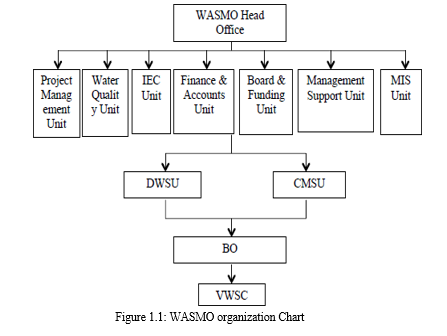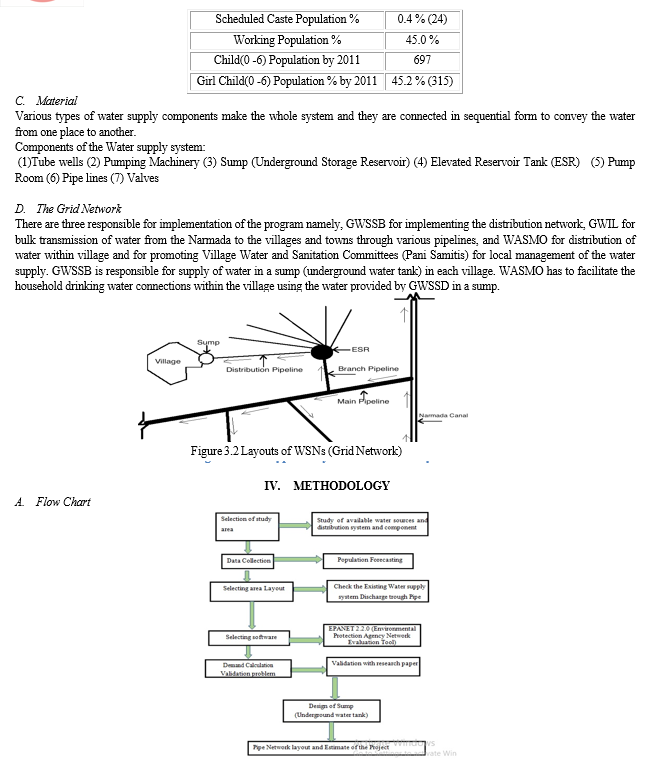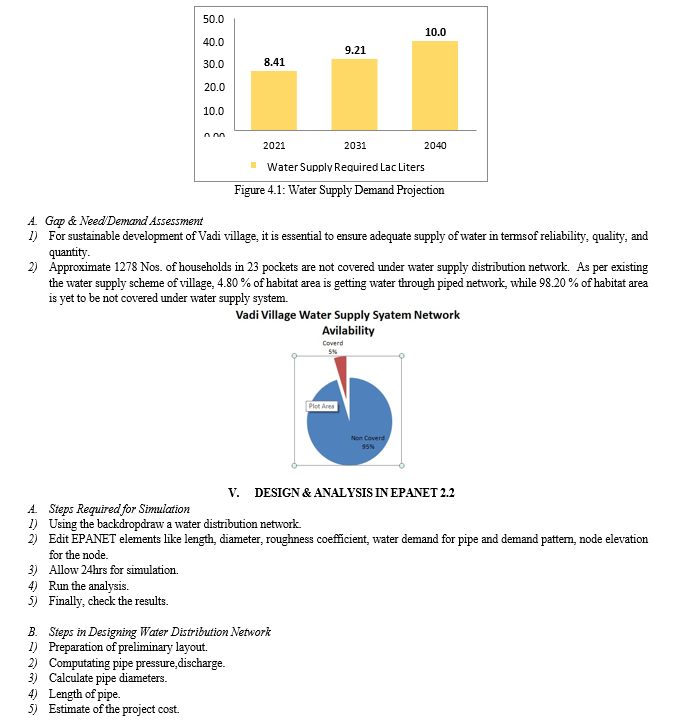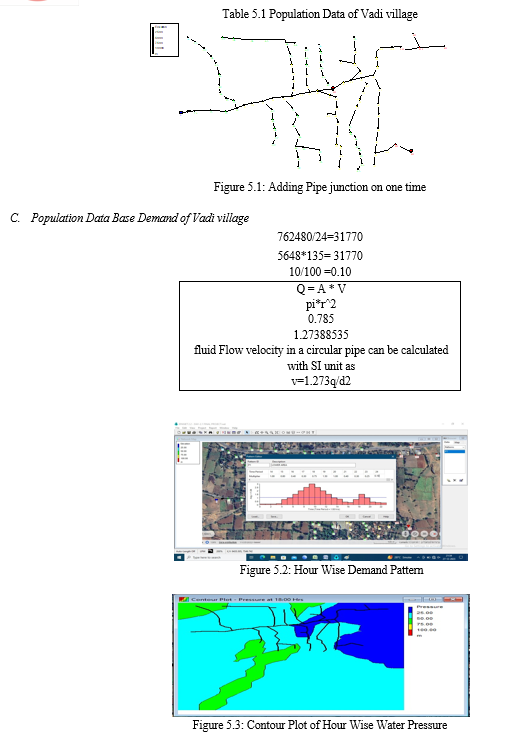Ijraset Journal For Research in Applied Science and Engineering Technology
- Home / Ijraset
- On This Page
- Abstract
- Introduction
- Conclusion
- References
- Copyright
Design and Analysis of Water Distribution System Network for a Rural Area of Gujarat State by Using EPANET
Authors: Mr. Hardik Prajapati, Dr. Deepti Patel
DOI Link: https://doi.org/10.22214/ijraset.2024.61609
Certificate: View Certificate
Abstract
This study presents the use of EPANET software in the design of the water distribution network for Vadi village in Umarpada District, Gujarat State. The major purpose of providing a good distribution network is to provide sufficient pressure at each point with less loss. A water distribution network consists of pipes, tanks etc. EPANET software is simulation tool which is used for efficient distribution of water supply. For the analysis of existing water distribution system various data are required like, Main water source, Population of the area, Demand for water, Requirement of the pumps, Distribution Network, and water tanks. The Google Earth Image of Vadi village is downloaded and the elevation of a node, length of pipe was recorded for nearly 112 junctions and 114 pipes. These data were used in EPANET software for analysis of Pressure, Head loss, and Elevation. This analysis resulted in pressure and elevation at various nodes and head loss at various pipes. The aim of our project is to analyses the water shortage problem of the vadi village and to supply safe wholesome water to the people of village up to 2051. The use of EPANET software has proven to be time saving and its application is especially for the analysis of larger distribution networks is recommended.
Introduction
I. INTRODUCTION
The design of water distribution system plays an important role which can overcome the water scarcity and the water demand by the users. Water distribution system is a hydraulic design leads to supply of water to the consumers, which consisting of pipes, tanks, reservoirs, pumps and valves etc.
Hence, it is necessary to supply water to the consumers efficiently so that the water could be used by the users to meet their demands. It can be achieved by designing a proper water distribution network.
The Vadi is one such village in Umarpada district where it takes many efforts to provide and reliable services to the citizens. Water supply is major part of it. It provides sufficient quality to every citizen at optimal cost but quantity is not satisfactory. As per collected data from governmental organization quantity of water supplied to the consumers is not satisfactory as per our survey the area receives water by Hand pumps and bore wells. Although there are certain problems reported by consumer and in order to tackle these problems, we decided to design the water distribution network by EPANET Software hence it will be helpful to Gram panchayat in future to laid pipe line and all essential elements of distribution network of water supply scheme in Vadi village.
A. Ground Water
Groundwater is fresh water located in the subsurface pore space of soil and rocks. It is also water that is flowing within aquifers below the water table.
Groundwater can be thought of in the same terms as surface water: inputs, outputs and storage. The critical difference is that due to its slow rate of turnover, groundwater storage is generally much larger (in volume) compared to inputs than it is for surface water. This difference makes it easy for humans to use groundwater unsustainably for a long time without severe consequences. Nevertheless, over the long term the average rate of seepage above a groundwater source is the upper bound for average consumption of water from that source
Table 1.1 Stage of Ground Water Extraction
|
Sl. No |
Category |
GWRA-2017 |
GWRA- 2020 |
GWRA-2022 |
GWRA-2023 |
||||
|
Number of AUs |
% of AUs |
Number of AUs |
% of AUs |
Number of AUs |
% of AUs |
Number of AUs |
% of AUs |
||
|
1 |
Safe |
194 |
78 |
182 |
73 |
189 |
75 |
189 |
75 |
|
2 |
Semi-critical |
11 |
4 |
24 |
10 |
20 |
8 |
20 |
8 |
|
3 |
Critical |
5 |
2 |
4 |
2 |
7 |
3 |
8 |
3 |
|
4 |
Over- exploited |
25 |
10 |
25 |
10 |
23 |
9 |
23 |
9 |
|
5 |
Saline |
13 |
5 |
13 |
5 |
13 |
5 |
12 |
5 |
|
Total number of AUs |
248 |
|
248 |
|
252 |
|
252 |
|
|
B. WASMO
WASMO was created for bringing perceptible systemic changes through a paradigm shift in the role of governance from provider to facilitator and citizen’s engagement in drinking water service delivery at users’ level in rural areas of Gujarat State. In 1993, the 73rd Amendment to the Constitution created a paradigm shift in the drinking water sector.

C. ???????AIM of Study
To analyze the existing Water Distribution Network of Vadi Falia area of Vadi Village using hydraulic simulation software i.e. EPANET 2.2 and to report any improvements required in existing network and the mode of operation, in order to improve the quantity and quality of water distributed to the users and Provide 55 liters of tap water to every rural house under Jal Jeevan Mission, Har Ghar Jal Scheme initiated by Ministry of GOI.
???????D. Objective of Study
The overall objective of the project is to improve existing service level of drinking water supply system. The people those who are living in unhygienic area , harm their health by dunking unsafe , water from open locally constructed storage facility , so it is quiet essential to improved their health and living standard by providing them potable and safe drinking water up to their doorstep and safe immediate objective are considered as under .
- To find out water demand calculation of Vadi Faliya area in vadi Village.
- Analysis and Design of Water Distribution Network for Steady State condition.
- To find out Optimum Diameter for the Water Distribution Network.
- To improve the quantity and quality of drinking water by upgrading in village water supply system ensuring sustainable source
- Providing from no tap connection to 100% House Hold Tap Water connectivity in Just One Year! To enumerate all the hydraulic parameters for the designed network using EPANET 2.2 Software.
II. LITERATURE REVIEW
Md Belal Hossain, Nirmal Chandra Roy, (2021) This paper represents the analysis and design of the Water Distribution Network (WDN) system using EPANET for Hajee Mohammad Danesh Science and Technology University (HSTU), Dinajpur, Bangladesh. Supply of water is essentially required for academic, administrative, student hostel and residential buildings according to their occupancies. Water supply system with sufficient pressure head and technical sustainability is nowadays a challenging task for the researcher, respected authority and government tackling the crisis in provided safe water due to the rapid increase in population. EPANET is public domain software developed by the US Environmental Protection Agency (EPA) which is used widely to design and analysis of water supply network system with reference to technical sustainability.
Dr. G. Venkata Ramanaa, (2021) In order to ensure the availability of sufficient quantity of good quality of water to the various section of community in Accordance with the demand. Many computer tools were developed, out of all the tools available EPANET become most popular and convenient for the effective design of complex pipe networks. This paper highlights only the effective design and distribution of network of pipes using EPANET tool. The residual head at each and every node was found out by having the elevation as input and thereby the corresponding flow quantities were derived like residual head, velocity and nodal demand etc.
Darshan Mehta, (2006) Pipe network analysis is the fluid flow through a hydraulics network containing several or many inter connected branches whose aim is to determine the flow rates and pressure drops in the individual sections of the network. Classical approach for automatically solving the problems of network is by using specialized software such as EPANET. The purpose of this study is to assess the performance of Limbayat zone water supply scheme using hydraulic simulation software and to address any improvements required to existing infrastructure and/or the mode of operation, in order to improve quantity and quality of water distributed to the consumers. As, Limbayat zone is facing water scarcity problem.
Wiwik Yunarni Widiarti, (2006) Fulfillments of drinking water needs are one of the government programs to support the Achievement of the target of Sustainable Development Goals (SDGs). One of the important parameters in the fulfillment of drinking water needs is a good distribution system. The aims of this research are to create a design to analyze the hydraulic model of drinking water distribution. The utilized model involved the EPANET 2.2 software. The utilized data included land elevation, pipe distribution base map, population, and discharge.
G. Anisha (2016) The analysis is carried out based on various public demands, quantities of inflows and out flows of the over-head reservoirs. This analysis provides the information about various demands, losses, and uses of the public. The design of a new network of supply will make the municipality be aware of the new demands, rate of increase in the demands. The design is made keeping in view of the population growth rate, and the developing town. The design brings out an improvement in the existing network.
Bhavana Ajudiya, (2012) This paper concerns for the design of rural water distribution systems in developing countries. Most of population of India is staying in rural area. At end of nineteen century community is not getting water at their resident in the village. But water is basic need of human being and it is directly effect on human health. Indian government is decided to provide safe, regular and adequate water to the community at their resident. It is helpful to water supply engineers are facing the problem of designing new distribution network in haphazard developed rural area.
Vipinkumar G Yadav, (2015) Water supply system is a system of engineered hydrologic and hydraulic components which provide water supply. Water is one of the basic necessities of every living being in the world. Water demand is increasing day by day whether it is domestic, industrial and agricultural etc., but the source of water is limited. So, authorities around the world are faced with the problem to provide sufficient water from limited water source. Water distribution network are very important for development of an area as they serve many purposes in addition to the provision of water for human consumption and it directly influences the nation’s development.
Dr. G. Venkata Ramana, (2015) In order to ensure the availability of sufficient quantity of good quality of water to the various section of community in accordance with the demand. Many computer tools were developed, out of all the tools available EPANET become most popular and convenient for the effective design of complex pipe networks. This paper highlights only the effective design and distribution of network of pipes using EPANET tool.
Mr. M Sundaravaldivel, (2019) Water supply for drinking and domestic uses is an essential basic requirement for households and communities. Unlike in large urban settlements, for small communities in rural and outback areas conventional methods of water sourcing, extraction, and, supply are not cost effective. Especially so in the rural areas of developing countries, which need simple, alternative methods to satisfy their domestic water needs. Water supply to such rural communities can be sourced from rain water, groundwater or spring/surface water.
Mr. Krishna Pagilla, (2008) In conducting a survey of the population we found that Pignon is in need of a sustainable water supply and distribution system. We had no prior available data on the town, so we collected elevation data, figured water demand and modeled it against the supply, mapped the entire town, took a census of the population, and analyzed the flaws of the existing system. In examining the spring caps and stand pipe we found that it was necessary to repair them.
III. STUDY AREA & DATA COLLECTION
A. Location Specifications
Area of study location: Google Earth application as used in this study enhanced the extraction of the area of study location from the spatial cloud before it was traced in EPANET 2.2 interface and later developed into the network for which the analysis was carried out. Vadi Village Gram Panchayat name is Vadi. Vadi is 17 km distance from Sub District Head Quarter Umarpada and it is 99 km distance from District Head Quarter Surat. Nearest Statutory Town is Mandvi in 27 km Distance. Vadi Total area is 921.3 hectares, Forest area is 226.27 hectares, Non-Agricultural area is 213.5 hectares, Total irrigated area is 32.2 hectares and Total Water fall area is 0 hectares


B. Design Considerations
The layout of the distribution network is drawn based on the existing road pattern .Length of the pipe is taken as the road length. The diameter of the pipe is considered based on the purpose served by the pipe, such as main, sub main, branch pipes. Pipe roughness coefficient is taken 120, since Galvanized Iron pipes are used. The simulation period was set for 24 hours.
C. Demand Calculation
Geometrical Increase Method is used for population forecasting. In this method the percentage increase in population from decade to decade is assumed to remain constant. Geometric mean increase is used to find out the future increment in population.
D. Steps in Using EPANET
Initially draw a network representation of distribution system from the extracted map. Then edit the properties of the objects that make up the system. The input parameters for each nodes and pipes are to be properly assigned. Describe how the system is operated. Then select a set of analysis options. Finally run a hydraulic/water quality analysis. The last step is to view the results of the analysis.
E. Model Input Parameters
In order to analyze the water distribution network using EPANET following input data files are needed:
- Junction Report: Junctions are points in the network where links join together and where water enters or leaves the network. The basic input data required for junctions are:
- Elevation above some reference (usually mean sea level)
- Water demand (rate of withdrawal from the network)
- Initial water quality the output results computed for junctions at all time periods of a simulation are:
- Hydraulic head (internal energy per unit weight of fluid)
- Pressure
- Water quality
2. Pipe Report: Pipes are links that convey water from one point in the network to another. EPANET assumes that all pipes are full at all times. Flow direction is from the end at higher hydraulic head (internal energy per weight of water) to that at lower head.
The principal hydraulic input parameters for pipes are:
- Start and end nodes
- Diameter
- Length
- Roughness coefficient (for determining Head-loss)
- Status (open, closed, or contains a check valve)
The output results for pipes include:
- Flow rate
- Velocity
- Head-loss
- Darcy-Weisbach friction factor
- Average reaction rate (over the pipe length)
- Average water quality
The hydraulic head lost by water flowing in a pipe due to friction with the pipe walls can be computed using one of three different formulas:
• Hazen-Williams formula
• Darcy-Weisbach formula
• Chezy-Manning formula The Hazen-Williams formula is the most commonly used head loss formula in Kerala by Kerala Water Authority.
|
HOUR |
1 |
2 |
3 |
4 |
5 |
6 |
7 |
8 |
9 |
10 |
11 |
12 |
|
FACTOR |
0.10 |
0.10 |
0.10 |
0.15 |
0.75 |
1.00 |
1.50 |
2.00 |
2.50 |
2.00 |
1.50 |
2.00 |
|
HOUR |
13 |
14 |
15 |
16 |
17 |
18 |
19 |
20 |
21 |
22 |
23 |
24 |
|
FACTOR |
1.50 |
1.00 |
0..80 |
0.40 |
0.30 |
0.75 |
1.50 |
1.00 |
0.40 |
0.30 |
0.25 |
0.10 |



VII. RECOMMENDATIONS
Formation of Pani Samiti with consensus of people in Gram Sabha (2) Participatory Rural Appraisal with community involvement (3) Preparation of Village Action Plan by community Implementation of the Scheme by community (4) Independent Financial Operations by Pani Samiti with guidance of WASMO (5) Operation & Maintenance of System by Community (6) Capacity building of the Pani Samiti and sharing of information with villagers
VIII. ACKNOWLEDGMENT
The authors are thankful to Faculty Guide, HOD, Principal Sir BMCET, Bhagwan Mahavir University, Surat. to permit them to carry out work. The authors are thankful to all technical staff members of Civil Engineering Department, BMCET for providing guidance.
Conclusion
The values for pressure, head loss and velocity of flow generated by the EPANET 2.2 simulation were validated. The need to validate or check the results obtained from the hydraulic solver as presented in table 3 and 4 is very important to ascertain that the calibration done at the conception of the simulation is in line with the hydraulic principles adopted as used in real life situation. At the end of the analysis it was found that the resulting pressures at all the nodes and the flows with their velocities at all links are sufficient enough to provide water to the study area. The prime consideration of this study was to analyze and design of a water distribution network for Vadi Village. Total number of 112 nodes, 114 links, 2 elevated storage tanks and 2 pumps are provided in distribution network to meet the water requirement. The evaluation tools have been explored throughout the case study to identify the poor performance, network expansion points, nodes demand requirement. Highest and lowest pressure for node is generated within the range from 11.44 m to 21.61 m which is much higher than the 10 m or 1 bar required to maintain service standard of water supply. About 45.5% nodes having pressure above 20 m, percentage of node having pressure within 15 m to 20 m is 50% and 4.5% nodes having pressure below 15 m. Flow through the pipes ranges from 0.013 LPS to 29.332 LPS. Percentage of the number of pipes having velocity above 1 m/s is 4.5%, 71.5% pipes having velocity within the range between 0.2 m/s to 1 meter per second and rest of the 24% pipes having velocity below 0.2 m/s. Considering the above all the factors, the design and design periods of different component & Cost Estimation of the water supply system has been established in vadi village for provision of good quality of water under Jal Jeevan Mission, Har Ghar Jal Scheme initiated by Ministry of GOI.
References
[1] “Vadi Gram Panchayat- Water Supply & Sanitation Committee” (Sarpanch) Mr.Daljibhai Patel) [2] \"Water and Sanitation Management Organization (WASMO)” Assistant Manager: Mr. Rakesh Judal. [3] Md Belal Hossain, Nirmal Chandra Roy “ Analysis and Design of Water Distribution Network Using EPANET” A Case Study of HSTU Campus of Dinajpur, Bangladesh, Hydrology, science publishing group, March 2021 [4] Dr. G. Venkata Ramanaa “Network analysis of water distribution system in rural areas using EPANET’’ Science Direct, Computer Control for Water Industry Conference, March 2021 [5] Darshan Mehta “Study of Water Distribution Network Using EPANET’’ IRJET, April 2006 [6] Wiwik Yunarni Widiarti “Evaluation of pipe network distribution system using EPANET 2.2” Earth and Environmental Science 437 (2020) 012043, April 2006 [7] G. Anisha “Analysis and Design of Water Distribution Network Using EPANET for Chirala Municipality in Prakasam District of Andhra Pradesh” International Journal of Engineering and Applied Sciences (IJEAS), April 2016 [8] Bhavana Ajudiya “Water Distribution Network Design and Analysis” Marwadi Education Foundation’s Group of Institute, March 2012 [9] Vipinkumar G Yadav and Darshan Mehta “To assess the prevailing Water Distribution Network using EPANET” IRJET Volume: 02 Issue: 08, Nov-2015 [10] Dr. G. Venkata Ramana, “Network analysis of water distribution system in rural areas using EPANET” CCWI, OCT 2015 [11] Mr. M Sundaravaldivel “Rural water supply system” Wastewater Recycle, Reuse, and reclamation vol-2, 31 Jan 2019 [12] Mr. Krishna Pagilla “Design of Sustainable Water Supply and Distribution System for Pignon, Haiti” United States Environmental Protection Agency, 29 May 2008 [13] P.L. Iglesias, F.J. Martínez, J.V. Ribelles, “Extending EPANET capabilities with Add-In Tools” (2016) ScienceDirect Procedia Engineering 186, Page 626 – 634, 2017 [14] Nisha Patel, Ankita Parmar, “Water Distribution Network using EPANET: A Case Study of Olpad Village, Surat district, Gujarat”, GRD Journal for Engineering, (Vol.4, No. 09), Feb 2019 [15] A.M. Georgescua, S. Perjua, S.C. Georgescub, L. Hasaean, “Estimation of the Efficiency for Variable Speed Pumps in EPANET Compared with Experimental Data”, ScienceDirect Procedia Engineering 89, Page 1404 – 1411, 2014 [16] G. Anisha, J. Ashok Kumar, P. Suvarna Raju, “Analysis & Design of Water Distribution Network Using EPANET for Chirala Municipality in Prakasam District Andra-Pradesh” International Journal of Engineering and Applied Sciences (IJEAS), Volume-3, Issue-4, April 2016 [17] J. Muranho, A. Ferreira, A. Gomes, A. Sá Marques, “Technical performance evaluation of water distribution networks based on EPANET”, ScienceDirect Procedia Engineering 70, Pages 1201 1210,2014 [18] I.I. Nwajuaku, Y.M. Wakawa, O.J. Adibeli, “Analysis of Head-loss Equations under EPANET and Hardy Cross Method”, Saudi Journal of Engineering and Technology, March 2017 [19] Ashwini Gajbhiye, P. Hari Prasad Reddy, A. P. Sargaonkar, “Modelling Leakage in Water Distribution System Using EPANET” Journal of Civil Engineering and Environmental Technology, Volume 4, Issue 3, April-June 2017 ScienceDirect Procedia Engineering 70,Pages 1192 – 1200, 201
Copyright
Copyright © 2024 Mr. Hardik Prajapati, Dr. Deepti Patel. This is an open access article distributed under the Creative Commons Attribution License, which permits unrestricted use, distribution, and reproduction in any medium, provided the original work is properly cited.

Download Paper
Paper Id : IJRASET61609
Publish Date : 2024-05-05
ISSN : 2321-9653
Publisher Name : IJRASET
DOI Link : Click Here
 Submit Paper Online
Submit Paper Online

